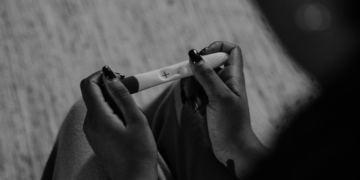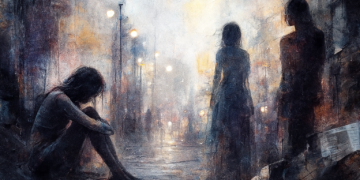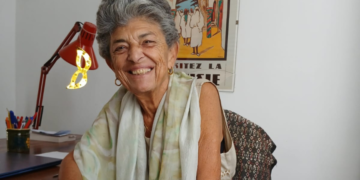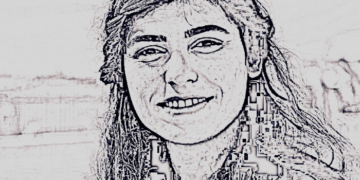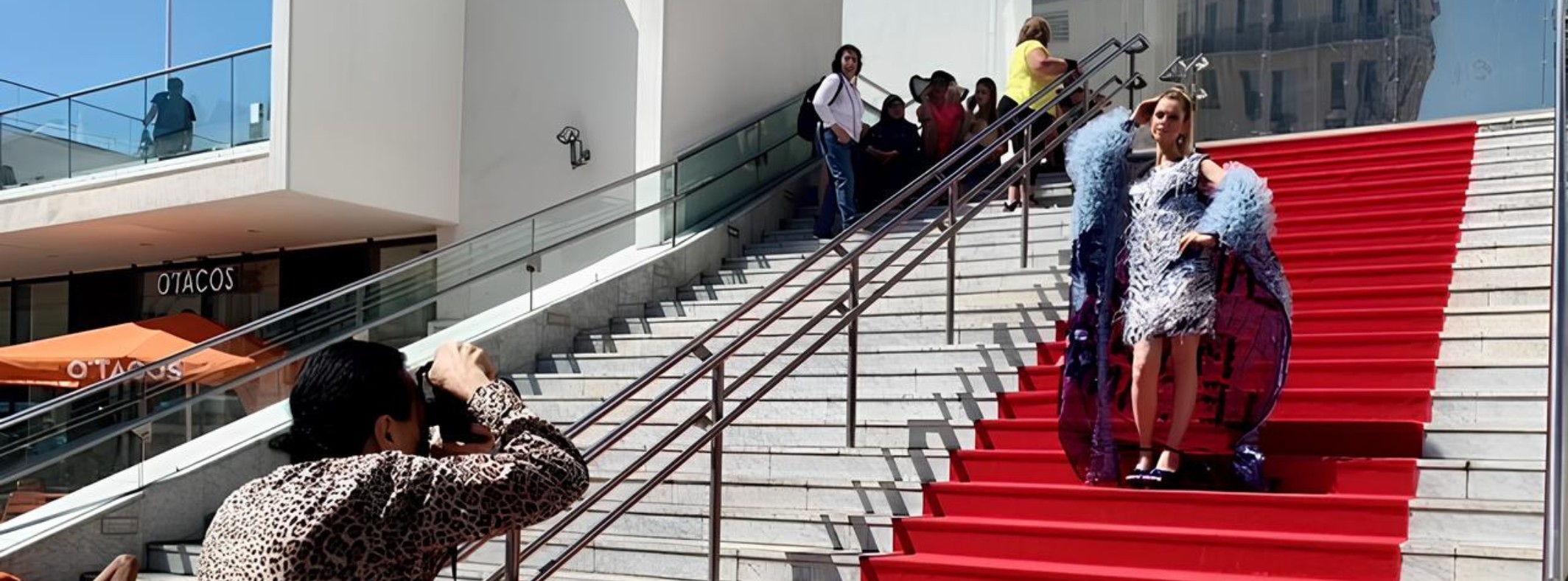This post is also available in: Français (French) العربية (Arabic)
“Olala, I’m going to become a star, I feel like I’m in Hollywood!”
“Why do you say that?”
“Well, you’re handing me a microphone—that means I’m going to become famous!”
On the other side of the outstretched recorder, Océane’s eyes are sparkling. In front of the steps of the Palais des Festivals in Cannes, the high school student with long, false eyelashes begins to dream: perhaps they’ve finally arrived, those notorious fifteen minutes of fame.

The high mass was set to begin in two weeks, and the red carpet was only partially laid out. There was commotion all around: workers were busy making this banal convention center into an apt setting to host the entirety of the seventh art. Already, tourists were flocking to pose like their favorite celebrities on the only few steps that so far had been draped in the iconic red—the joy of treading on the same ground as one’s idol, but one that must quickly be taken advantage of, because soon all public spaces will be sectioned off.
But Océane and her friend Manon are not tourists. They live a few kilometers away, in Vallauris and Grasse, between the very chic Antibes and Cannes. This year, they are 16 years old, still baby-faced but defiant in spirit. With a little levity, they could try to get past the barriers standing between them and all that shines. Failing that, they’d go relax on one of the beaches of the Croisette, their preferred spot for sunbathing.
A very red carpet
The Palais des Festivals—which is also nicknamed the bunker for its brutalist appearance—has hosted the Film Festival since 1982, instead of the Palais Croisette, the very symbolic post-war building. During the Liberation, the Cannes mayor Raymond Picaud, who was given a thousand titles: socialist, former resistance fighter, and doctor of the poor, had worked extensively to welcome this aborted cultural project into his city. The idea of a democratic film festival first began in the 1930s, with the Popular Front and particularly with Jean Zay, the Minister of Fine Arts, in opposition to the Venice Film Festival (Mostra de Venise), then in the hands of the fascist propaganda of Mussolini and Hitler. But this social history is well buried under the carpet.
Each climb up the steps now begins as a very codified parade. The architecture of the bunker favors a much more calculated implementation than in the era of the likes of Jean Gabin and Michèle Morgane. The 280 or so photographers present are lined up in rows, so as to keep them distant from the stars: their hand movements must be quick, rapid enough to capture the iconic shot that will make it to the double-page feature on glossy paper.
Women from every angle
It’s the first weekend of festivities and Johanna, 24, has come specially from Juan-les-Pins to witness the start of this unusual parade with no mascots—no Mickey or Minnie. On tiptoe, she leans against one of the many movable safety barricades, an attempt to satisfy her curiosity and try to catch a glimpse of whatever’s between the CRS and the armored vans. A host roars the names of the artists into a microphone, above the festive background music. The young woman has been coming to the festival every year since she was 12. “For me and my friends, this has always been *the* event. There are never so many people around here. The atmosphere is nice, even if it’s been getting less and less pleasant,” Johanna explains.
That same weekend, Océane and Manon had also decided to show up. The former took the train from Vallauris to meet the latter, whose mother had driven her. They sit at the McDonald’s located on the extension of the Croisette, opposite the yachts moored at Port Canto. Even the fast-food restaurant looks chic with its clean white facade. No cause to be envious of the luxury brands. Océane carefully touches up her makeup, using the Snapchat app as a mirror. “It’s the Festival, you have to look your absolute best every second,” she jokes.
The two high school students sit on the terrace of the fast-food restaurant to avoid the crowds that had gathered around the Palais. But a few minutes later, they’re off again for the big tour. For them, these queues are like those at Disneyland—except here, there are no admission tickets to be bought. “Come on, let’s pretend we have invitations!” Manon says playfully. She dreams of working in the luxury market and casts furtive glances at the storefronts along the Croisette. “I’ve never been inside because there are security guards outside the luxury boutiques. And security guards scare me. Anyway, I don’t think we’re allowed in; we’re dressed like normal people.” Her friend agrees. The only women she’d seen going into these shops were in dazzling designer dresses. Despite everything, Manon respects all these conventions. “It wouldn’t be Cannes without these spaces reserved for the most important people in society!” Sparkling in rhinestones and glitter but tired of the hustle and bustle, they end their race on the Plage Macé, the public beach adjacent to the Palais.
Johanna, on the other hand, has distanced herself from these imposed norms. “I’ve always worked on the beaches, so it’s swimsuits from 7 AM to 9 PM for me. But I’m not more comfortable with my body, and I’m not any less affected by beauty standards. Especially during the Festival, when there’s models everywhere,” the student explains.
Still, on the other side of the barricade, Johanna remains lucid. “[The seventh art] is an important art… but this phenomenon of idolatry is a little scary. Honestly, it’s totally disconnected from reality. I think that right now, there are things that cameras shouldn’t be filming anymore.”
On the Plage Macé, Lilia, 18, lounges in a bikini, a friend by her side, indifferent to all the commotion of the great seventh art. The Cannes native lives in the Carnot area, behind the station. She too has felt pressure regarding her appearance since she was very young. A “competition,” she says, to be the most beautiful, to wear the prettiest outfits, the most fashionable accessories, in a city where luxury is ostentatious. The competition is tough, and one has to play the game, even when “we are not financially well off.”
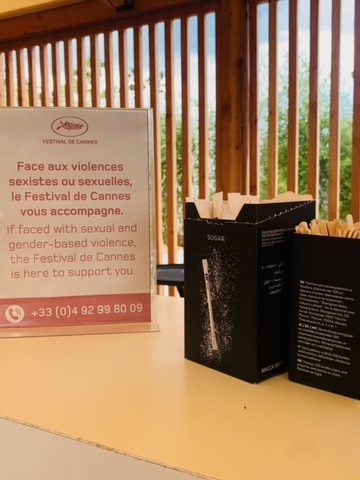
Among other young women parading around in evening gowns, complete teams of hairdressers, stylists, and makeup artists close behind, Johanna has learned to distinguish fact from fiction. “When I was younger, all I could see was the things that shine. My goal was to get into a party. And it wasn’t that complicated; I wasn’t even 18 when I managed to…” She hesitates, then continues, “It’s a little insane, but it also reflects a lot of the things we hear about Cannes.” Today, she is glad to see a small poster mentioning gender-based and sexual violence with a hotline number available for calls. But one has to see it first—the sign is placed right next to an overwhelming Dior advertisement. This year, the Festival declared wanting to avoid politics. It must be a “festival without controversy,” as Thierry Frémaux, the General Delegate of the Festival, insisted at a press conference.
Everyone in their place
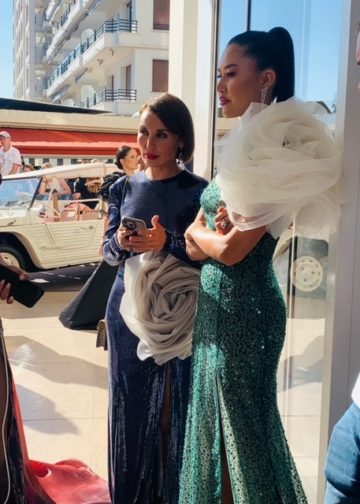
At Cannes, there are a lot of barricades and a lot of queues. To access the VIP zones in nightclubs, to go to a private beach, to enter a luxury boutique. During the Festival, these walls of separation multiply—and with them, the zones of privilege.
The Festival website speaks of a “magic that has worked uninterruptedly for decades.” It is certainly a precious moment for avid film fans, but it’s above all a major challenge for an entire industry. Only two weeks in the international film market to network and decide on the future of image fabrication. In relation to cinema but not only that: it’s also a meeting place for the fashion, luxury, media, and even influence industries. For professionals in the sector, the festivities feel much more like an endless seminar than a space for entertainment.
And the magic doesn’t work for Lilia, either. “It annoys everyone. Especially those who live here. It blocks our buses and all the roads. There are human traffic jams. Before, the people of Cannes had places to go, but it’s more restricted now,” she says.
At the top of the Festival’s small pyramid society sit the stars. In his essay Les Stars, Edgar Morin already described in 1957 this phenomenon of idolizing celebrities. The philosopher and sociologist claims that “the star-system wants beauties.” And that’s what the spotlights, the makeup, the unusual dresses, and the cameras are there for: to make people believe in the unattainable beauty of these characters. In short, to justify their physical or moral superiority, and therefore justify the resulting inequalities. When we allow ourselves to be lulled by the stories of the men- and women-turned-stars, we adhere to the incredible nature of their destiny. Fans and spectators allow these individuals to stand out from the crowd. Without anyone to look toward the lights, the star-system is no longer. And yet, fans are despised, often ridiculed in the media. Particularly fangirls, or groupies, who appeared in the 1960s with Beatlemania. Yet it is they who helped forge the legendary status of these British boys.
Still, on the other side of the barricade, Johanna remains lucid. “[The seventh art] is an important art… but this phenomenon of idolatry is a little scary. Honestly, it’s totally disconnected from reality. I think that right now, there are things that cameras shouldn’t be filming anymore.”
This investigation was carried out with the support of the AGEE - Alliance for Gender Equality in Europe.

